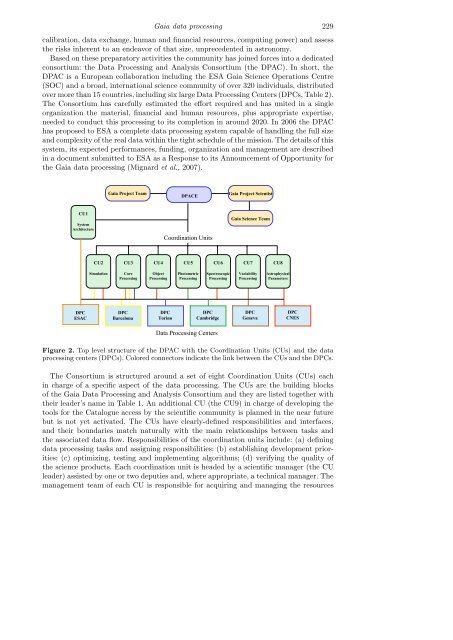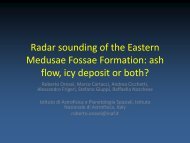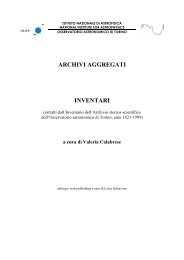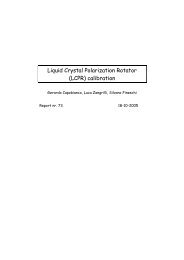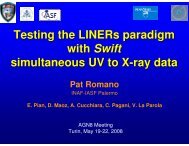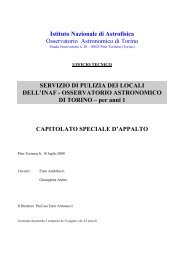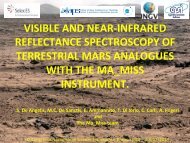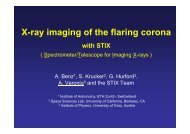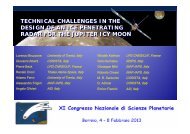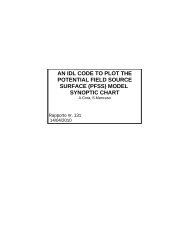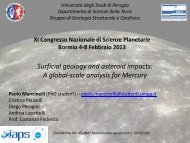Gaia - Osservatorio Astronomico di Torino
Gaia - Osservatorio Astronomico di Torino
Gaia - Osservatorio Astronomico di Torino
You also want an ePaper? Increase the reach of your titles
YUMPU automatically turns print PDFs into web optimized ePapers that Google loves.
<strong>Gaia</strong> data processing 229<br />
calibration, data exchange, human and financial resources, computing power) and assess<br />
the risks inherent to an endeavor of that size, unprecedented in astronomy.<br />
Based on these preparatory activities the community has joined forces into a de<strong>di</strong>cated<br />
consortium: the Data Processing and Analysis Consortium (the DPAC). In short, the<br />
DPAC is a European collaboration inclu<strong>di</strong>ng the ESA <strong>Gaia</strong> Science Operations Centre<br />
(SOC) and a broad, international science community of over 320 in<strong>di</strong>viduals, <strong>di</strong>stributed<br />
over more than 15 countries, inclu<strong>di</strong>ng six large Data Processing Centers (DPCs, Table 2).<br />
The Consortium has carefully estimated the effort required and has united in a single<br />
organization the material, financial and human resources, plus appropriate expertise,<br />
needed to conduct this processing to its completion in around 2020. In 2006 the DPAC<br />
has proposed to ESA a complete data processing system capable of handling the full size<br />
and complexity of the real data within the tight schedule of the mission. The details of this<br />
system, its expected performances, fun<strong>di</strong>ng, organization and management are described<br />
in a document submitted to ESA as a Response to its Announcement of Opportunity for<br />
the <strong>Gaia</strong> data processing (Mignard et al., 2007).<br />
<strong>Gaia</strong> Project Team<br />
DPACE<br />
<strong>Gaia</strong> Project Scientist<br />
CU1<br />
System<br />
Architecture<br />
Coor<strong>di</strong>nation Units<br />
<strong>Gaia</strong> Science Team<br />
CU2<br />
CU3<br />
CU4<br />
CU5<br />
CU6<br />
CU7<br />
CU8<br />
Simulation<br />
Core<br />
Processing<br />
Object<br />
Processing<br />
Photometric<br />
Processing<br />
Spectroscopic<br />
Processing<br />
Variability<br />
Processing<br />
Astrophysical<br />
Parameters<br />
DPC<br />
ESAC<br />
DPC<br />
Barcelona<br />
DPC<br />
<strong>Torino</strong><br />
DPC<br />
Cambridge<br />
DPC<br />
Geneva<br />
DPC<br />
CNES<br />
Data Processing Centers<br />
Figure 2. Top level structure of the DPAC with the Coor<strong>di</strong>nation Units (CUs) and the data<br />
processing centers (DPCs). Colored connectors in<strong>di</strong>cate the link between the CUs and the DPCs.<br />
The Consortium is structured around a set of eight Coor<strong>di</strong>nation Units (CUs) each<br />
in charge of a specific aspect of the data processing. The CUs are the buil<strong>di</strong>ng blocks<br />
of the <strong>Gaia</strong> Data Processing and Analysis Consortium and they are listed together with<br />
their leader’s name in Table 1. An ad<strong>di</strong>tional CU (the CU9) in charge of developing the<br />
tools for the Catalogue access by the scientific community is planned in the near future<br />
but is not yet activated. The CUs have clearly-defined responsibilities and interfaces,<br />
and their boundaries match naturally with the main relationships between tasks and<br />
the associated data flow. Responsibilities of the coor<strong>di</strong>nation units include: (a) defining<br />
data processing tasks and assigning responsibilities; (b) establishing development priorities;<br />
(c) optimizing, testing and implementing algorithms; (d) verifying the quality of<br />
the science products. Each coor<strong>di</strong>nation unit is headed by a scientific manager (the CU<br />
leader) assisted by one or two deputies and, where appropriate, a technical manager. The<br />
management team of each CU is responsible for acquiring and managing the resources


